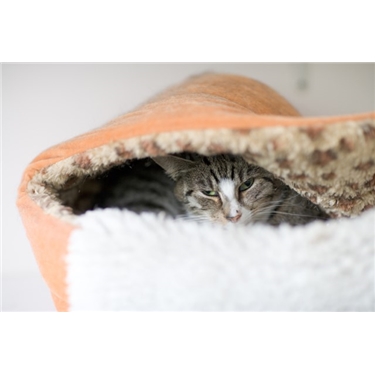Introducing a shy or nervous cat into a new home
21 March 2016

While most cats settle into new homes quickly, some remain fearful despite a gentle welcome and time to settle in. Don’t be too disappointed if your shy or timid cat tries to run away and hide from you. Showing patience and sensitivity will go a long way to ensure that you have a happy and extremely rewarding relationship with your cat.
Why is my cat so timid?
Timid behaviour could be due to:
• Genetics – an inherited tendency. Some cats are naturally more anxious than others
• Poor socialisation – a lack of contact with humans, particularly during their first eight weeks of life. If young kittens are not properly socialised with people, they will be frightened or stressed by human contact
• Bad experiences – a previous frightening experience that has made the cat fearful
What are the signs of shyness, nervousness or timidity?
As cats cannot tell us how they feel, it can be difficult to recognise that your cat wants you to move away. Signs of fear include running away and retreating to hiding places. A scared cat will show dilated pupils and/or flattened ears and will cringe and cower from you.
This fear can develop into aggressive behaviour – where your cat adopts ‘fight’ as a tactic instead of ‘flight’ as a last resort.
Usually aggression develops because the cat feels cornered or trapped, or because they have previously learned that flight is unsuccessful. Avoid putting your cat into this situation and ensure they can always get away easily if they want to.
Managing shy cats
There are a number of things you can do to make your timid cat feel more secure. As long as your cat had some positive contact with people when they were a young kitten, with patience your cat will learn not to be afraid but you must take things slowly. It helps to:
• When first introducing a new cat to your home, keep them in one room to start with. This will help the cat to relax and feel safe while bonding with it's new family before being given full access to the whole house.
• Provide plenty of refuges. Cats de-stress quicker if they can hide, preferably in high and dark locations eg behind sofas and under beds. A cardboard box on its side or blankets placed on shelves or wardrobes can help your cat feel safe.
• Ensure other neighbouring cats cannot enter the house through the cat flap or open windows. Be vigilant to make sure your cat is not being bullied in the garden or intimidated by other cats through the windows, conservatory or patio doors
• Keep all your daily routines consistent where possible. This provides a predictable, reassuring environment for your cat.
• Use synthetic scent pheromones – these can create a reassuring environment for the cat and may help to reduce stress – they are available from your vet (*See Feliway Notes below)
• Sit quietly in your cat’s vicinity to allow them to get used to you in their own time. Ignore them while you read a book or take a nap so that they don’t feel pressurised or anxious about your presence. Do it while they are eating or provide a small treat so they associate your presence with something
positive. The time you spend near them can very gradually be built up as they adjust
• Let your cat make the first move – direct approaches are extremely threatening so don’t force attention on your cat
• Blink slowly at your cat, narrow your eyes so they are half open and then turn your face away slowly to reassure your cat that you are not a threat
As your cat becomes braver, try:
• Talking to your cat quietly in a calming tone – it is a great way to bond
• Rewarding your cat with a treat when they approach you – at first, give the treat as soon as your cat approaches but gradually increase the time between the approach and the treat. Over a period of weeks, work up to being able to calmly stroke your cat once or twice before giving the treat
• Using small toys you can gently throw for them, such as ball of foil, scrunched up paper or ping pong ball. Fishing rod toys allow the cat to interact without them feeling threatened by close contact. Most importantly, never lose your temper or try to force your cat to interact too quickly as this will just reinforce their previous fears. Build on your successes gradually – eventually your cat will learn to trust you and will much happier. In some cases, you may find guidance from your vet or a suitably qualified behaviourist useful.
Overcoming a cat’s shyness through patient handling and care often leads to an extremely rewarding and close relationship between owner and cat and is well worth the extra time and effort.
* Feliway is an easy-to-use product that helps create a loving and comfortable home environment where your cat will spend more time with you. It is supplied as a plug-in diffuser. This special scent (odourless to people and other animals) that Feliway utilizes is a replication of the pheromone that cats leave naturally when they are feeling comfortable in their environment. Plug in a Feliway Diffuser, if possible, 48 hours before bringing your new cat home. The diffuser lasts four weeks and will help your cat adjust to its new home. For more information visit the website
http://www.feliway.com/uk